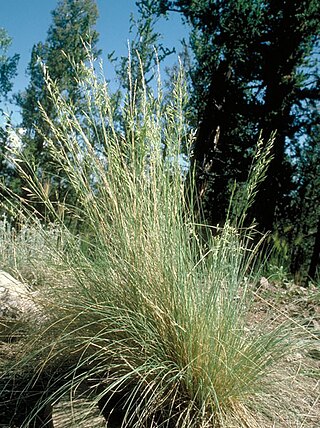
Festuca arizonica, commonly called Arizona fescue, is a grass found in western North America, in the southwest United States and northern Mexico. This species also has the common names mountain bunchgrass and pinegrass.

Agrostis gigantea, known by its common names black bent and redtop, is a perennial grass of the Agrostis genus.

Calamagrostis canadensis is a species of grass, having three or more varieties, in the family Poaceae. It is known variously by the common names of bluejoint, bluejoint reedgrass, marsh reedgrass, Canadian reedgrass, meadow pinegrass, Canada bluejoint and marsh pinegrass.

Aristida oligantha is a species of grass known by the common names prairie threeawn and oldfield threeawn.

Calamovilfa is a genus of North American plants in the grass family native to the United States and Canada.

Palafoxia arida is a species of flowering plant in the aster family, known by the common names desert palafox and Spanish needle.

Panicum dichotomiflorum, known by the common names fall panicgrass, autumn millet, and fall panicum is a species of Poaceae "true grass". It is native to much of the eastern United States and parts of Canada, and it can be found in the Western United States through California. It may be an introduced species in some western climates. It grows in many types of habitat, including disturbed areas and chaparral habitats.

Poa douglasii is a species of grass known by the common names Douglas' bluegrass and sand dune bluegrass. It is endemic to the coastline of California, where it grows in shifting sand dunes. It can be found mostly along the Central Coast and Channel Islands, and occasionally on the North Coast north of Mendocino. It is a perennial grass growing small, dense clumps up to about 30 centimeters in maximum height. It grows from a network of long rhizomes and stolons that anchor the grass to its loose sandy substrate; this network may be up to one meter long. The inflorescence is a dense, oval-shaped series of overlapping spikelets. The grass is dioecious, with male and female individuals producing different types of flowers in their inflorescences. This species, like many sand-dune endemic plants, is threatened by invasive species.
Puccinellia nutkaensis is a species of grass known by the common names Nootka alkaligrass and Alaska alkali grass. It is native to North America from Alaska across northern Canada to Greenland and Nova Scotia, and down to Washington to Oregon to the Central Coast of California.

Selaginella densa is a species of spikemoss known by the common names lesser spikemoss, prairie spikemoss, and Rocky Mountains spikemoss. It is native to western North America, where it can be found from Alaska to Ontario, the Dakotas, Texas and far northern California.
Tridens muticus is a species of grass known by the common name slim tridens. It is native to Mexico and the southwestern quadrant of the United States.
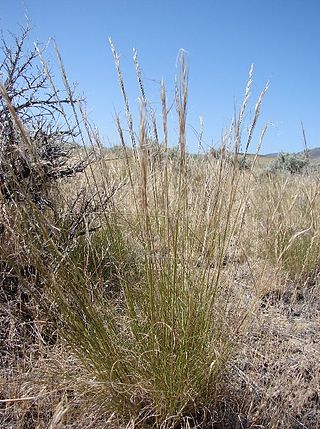
Eriocoma thurberiana is a species of grass known by the common name Thurber's needlegrass. It is native to the western United States, where it occurs from Washington to California and east to Montana and Wyoming.

Calamovilfa longifolia is a species of grass known by the common names prairie sandreed and sand reedgrass. It is native to North America, where it occurs from the Northwest Territories to Ontario in Canada and as far south as New Mexico and Kansas in the United States. There are two varieties, var. longifolia being widespread in the species' range and var. magna being native to the Great Lakes region.
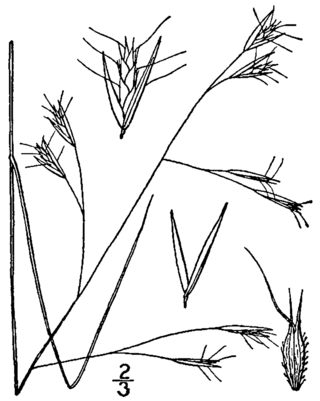
Danthonia compressa is a species of grass known by the common names mountain oatgrass, flattened oatgrass, and slender oatgrass.
Aristida rhizomophora is a species of grass known by the common name Florida threeawn. It is endemic to Florida in the United States.
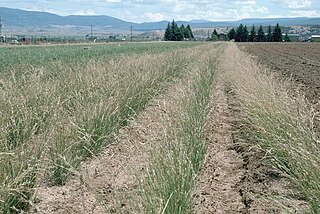
Bromus marginatus is a species of grass known by the common name mountain brome. It is native to western North America, and it is used widely for grazing animals and revegetating landscapes.
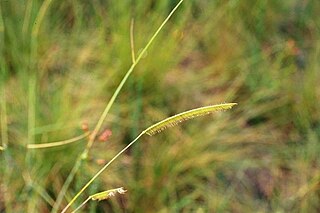
Ctenium aromaticum is a species of grass known by the common name toothache grass. It is native to the southeastern United States, where it grows on the coastal plain.

Pityopsis graminifolia is a species of flowering plant in the family Asteraceae known by the common names grass-leaved golden-aster and narrowleaf silkgrass. It is native to the southeastern United States, occurring as far north as Ohio and Maryland.

Trichloris crinita is a species of grass known by the common name false Rhodes grass. It is native to the Americas, where it occurs in the southwestern United States, northern Mexico, and parts of Argentina.

Setaria palmifolia is a species of grass known by the common names palmgrass, highland pitpit, hailans pitpit, short pitpit, broadleaved bristlegrass, and knotroot. It is native to temperate and tropical Asia. It is known elsewhere as an introduced, and often invasive, species, including in Australia, New Zealand, many Pacific Islands, and the Americas.

















